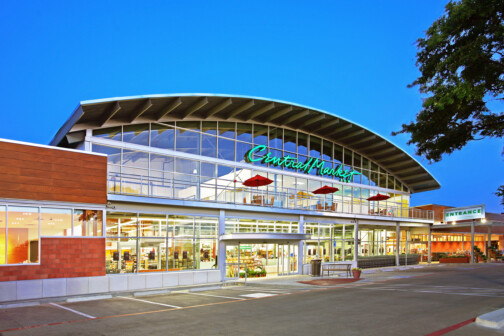Carlson’s first idea, for instance, was to replicate Star Canyon in Fort Worth, North Dallas, and Houston. Pyles and Cox objected, saying that sister restaurants in Fort Worth or North Dallas would cannibalize the original. Houston, they maintained, was not ready for Star Canyon because of the city’s built-in bias against Dallas imports. Instead, an Austin Star Canyon opened in January in the Stephen F. Austin Hotel. “This is the only place in Texas it seemed like it would work—partly because of the special location,” says Cox. “Still, it’s all an experiment.”
Cox sounds tense when he talks about Carlson. “Lots of people think Carlson ruined Star Canyon and AquaKnox,” says Cox. “I wouldn’t say that.” But the tension between creative control and corporate consistency became acute. “To a certain extent, consistency quells creativity,” reflects Pyles, in the extremely cautious manner he has when discussing his partnership with Carlson.
“The corporate structure has its place in society,” Pyles adds. “In fact, I wonder if anyone can really understand the United States until you’ve worked in a big company. But that’s not me. I tried really hard to be part of the team, but what I learned from this venture is that I really need to stick to the basics—a kitchen, a dining room, and a chef. At one point I felt like I’d lost my soul. What I’ve done before has been all about me. This was very impersonal.” In Cox and Pyles’ view, the business side and creative control collided, and not unexpectedly. Royce Ring would beg to differ.
“I’m an entrepreneur, too,” insists Ring. Any restaurant, Ring maintains, has the desire—the need—to have things run congruently. And more and more, there has to be a compelling draw. Fine food isn’t all the consumer is looking for. “Having a real, identified chef in the kitchen was an interesting twist 10 years ago,” says Ring. Until that time, the kitchens in even top-flight restaurants were mostly manned by line cooks. “Now having a name chef is just a ticket to entry,” he points out. “And it’s not just because the Culinary Institute of America is flooding the workplace with trained chefs. Today the consumer is more aware and has higher expectations. You need a chef, not just in the kitchen, but also in the dining room to get to know the clientele. That personal connection keeps them coming back.”
Royce Ring compares what he’s trying to do with Wolfgang Reitzl’s efforts in the auto industry at Ford, which is blending the premium brands—BMW, Aston, Jaguar, Lincoln, Volvo, and Range Rover—with Ford Motor Company. “Five years ago,” says Ring, “when Ford bought Jaguar, everyone thought, ’Oh no, what’s going to happen to Jaguar? Surely the quality will slip.’ Actually, the electrical and the air conditioning systems are better, while the car retains its luxury. That’s a fair analogy to blending high-end dining with the advantages of a chain restaurant.”
Consistency and cost efficiency are the hallmarks of a corporate operation that can benefit even smaller operations. Everything that all restaurants require—cups, olive oil, sugar—can be purchased with a volume advantage. “You have a national contract with Coke, with maintenance companies. You can consolidate all kinds of efforts. If I need an attorney, we’ve got one on staff.”
Ring’s philosophy divides every restaurant into two parts that he labels the “chassis” and the “DNA.” The chassis is the infrastructure, the back-of-the-house stuff the customer never sees—the payroll system, for example. When that worry is taken away from the creative types, they can then concentrate on “concept-specific” issues—the look, feel, smell, the “DNA” that makes every property unique. In Ring’s view, you can have your cake and eat it, too.
Cox prefers another metaphor: He says that a chef-operated restaurant is like a Broadway show. With the original cast, in the intimacy of a New York theater, with the conceiving director and art director taking a hands-on interest, a show can be an electrifying, Tony Award-winning production. Seen on the road, with a traveling cast, moveable scenery, and directors as replaceable as light bulbs, a show is just a shadow of its former self. As Cox muses, “What are they truly buying when they buy a restaurant with one location? Can it really move?” Even 25 locations are tough with a high-end restaurant. Certainly not 500, like T.G.I. Friday’s.
The two philosophies have different metrics of success. One is all about the money. The other includes dollars and a degree of personal creative satisfaction. “The financial side is so tempting,” says Pyles. “They approached us, and the dollar signs were dazzling.”
But he feels he and Cox had finished what they were contracted to do for Carlson when they stepped away halfway through their five-year deal.
The question remains unanswered: Can a big chain really run a high-end restaurant? Currently, Carlson owns Samba Room, Timpano, Mignon, and Taqueria Cañonita, as well as Star Canyon and AquaKnox. Three or four Samba Rooms have opened in the last 18 months. The key to T.G.I. Friday’s and other restaurants in that category is saturation.
“You have to honor what they’ve done with Friday’s,” Cox adds, “but the high end is a different beast. No one ever asked us to sacrifice quality; no one ever told us we had to use frozen fish. But profit margins on high-end restaurants are barely higher than the retail grocery business, whereas multiple-unit restaurants run a profit of 15 to 20 percent.”
Ring answers that with his own plan. “I think we’re successful at both entrepreneurship and replication. We’re doing it a little differently. Conventional restaurant wisdom used to be that you get one brand and open it as fast as you can from coast to coast. That isn’t what my mission is. We have seven brands. It’s been two-and-a-half years, and we’re just now starting to replicate. We want each restaurant to be a star in its own city.”
Ring says that the chain restaurant is being redefined by the industry. “Restaurant use has shifted from demographic to occasion-based. It used to be people with lots of money in Dallas ate at Bob’s. People with less money ate at Olive Garden. Now there’s not such a split—all demographics use different types of restaurants for different occasions.” And with the new “restaurant collection” model replacing the replicated chain restaurant model, each restaurant in a collection might have its own chef with different specials, serving each neighborhood differently.
For a restaurant to move into other cities requires a huge infrastructure. The new strategy, explains Cox, is to develop regional market partners in a kind of high-end franchise. “P.F. Chang’s does this. You get someone regional who understands a specific market. That way you get a true operator instead of a franchise investor, but the operator is still buying a concept for a time and a price and a stream of the revenue. At the end of five years, the company can buy out the operator and in the meantime will have acquired that person’s local reputation, connections, and knowledge.”
So for the first six months of Star Concepts’ partnership with emerging brands, Ring was asking Cox questions. Do you keep track of people’s vacations? How do you file insurance claims? What’s the food cost on that plate? To Ring’s way of thinking, the stars of Star Canyon had a fairly laissez-faire attitude about daily operations. To Cox’s way of thinking, everything isn’t figured on paper.
For instance, “The only way I could open AquaKnox was with George Majdalani,” says Cox, “because I knew, loved, and trusted him. He’d run it the way I would. How do you hand over or train someone to run things from the heart? For me this is a people business. I want to depend on people, not polls. Those daily numbers were fine, but I already knew what they said because I’m in my restaurants.”
Both sides insist this was an amicable business split; each side professes the highest respect for the other. But there is a subtext of tension in the extremely careful tone everyone uses to discuss the deal. No one made a mistake. No one is even right or wrong. The disagreement between the two parties is deeper than that. What killed the deal between Carlson and Pyles was the same seemingly simple issue on which many businesses finally break—a fundamental difference of philosophy, a different answer to the question, “What are we working for?”
What’s next? Each group will go back to pursuing its own definitions of success. Carlson owns the whole Star Canyon shebang—the name, the concept, the logo—and will continue to operate Star Canyon because it adds luster to the high-end emerging brands portfolio.
“I’m as disaffiliated with it as possible,” Pyles says emphatically. “It has nothing to do with me.” For Cox and Pyles, their new ambition is to think smaller. This year Pyles is planning to travel—to Tibet, Nepal, China, Africa, and Morocco. He knows he’ll eventually open another restaurant.
“I want to reconnect with the kitchen. And reflect. Evolve what I’ve been doing all along. I want to get my reputation back. I think I was happiest the first few years at Star Canyon when it was our only little world, always a special event. One entity that produced a lot of satisfaction.”
Mary Brown Malouf is D Magazine’s former dining critic and executive editor. She is now the editor of wine.com.





